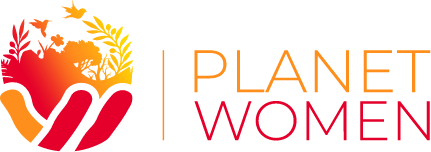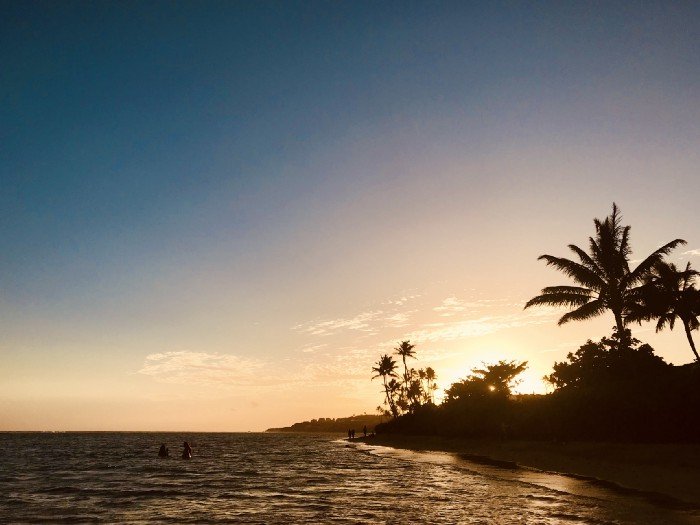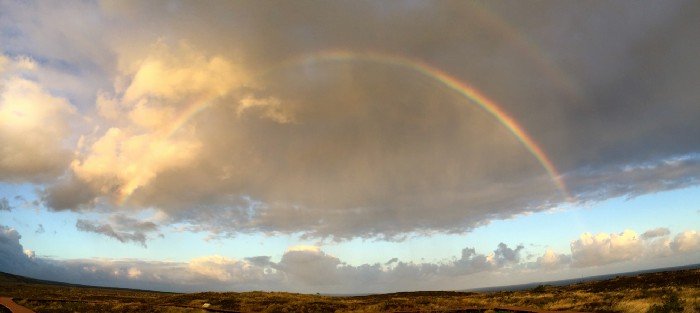Earth Day: Finding Solutions where People and Planet Intersect
By Liza Keānuenueokalani Williams, PhD, Director of Cultural Transformation, Planet Women
Kahala in Honolulu on Oʻahu, Hawaii, the island where Liza grew up. © Liza K. Williams
As humans, we have inherited this great, big, beautiful, green-blue planet. We are gifted food, sustenance, awe-inspiring beauty, health, regeneration, and much more from our planet’s lands and waters. As the most impactful species on the planet we have been offered the opportunity to learn more about how we fit into the interdependent web that creates all of life. We have been privileged to learn about the delicate balance of soil fertility, southern and northern hemispheric seasons, the migrations of animals, tidal changes, wind directions, climate temperature, ocean health, forest moisture, watersheds and how we as humans fit into the intricate balance of all of these ecosystems.
For many thousands of years we lived in balance with this interdependent web. We honored its rhythms. We deeply listened to the subtle changes that each day brought, in relation to the moon’s phases and sun’s position in the sky. We understood that all of this was not something to squander, but something to fiercely protect. We fiercely protected our Earth Mama as an extension of ourselves. She was our sacred family — our blood, our bones, our spirits, our ancestor, our descendants, and she gives us life — not only at the minute of our birth, but each and every day that we walk the planet throughout our lives.
Many cultures around the world, especially Indigenous cultures, understood that the Earth and her resources were precious, limited and innately valuable to all of life. I am Kanaka Maoli, also referred to as Native Hawaiian, and this reverence for land and nature was passed down to me from my mother’s mother, and I now teach this to my own daughter. Through my culture and the matrilineal line in my own family, I learned that both women and the earth were powerful, strong, resilient and valuable assets to life. But we — my grandmother, my mother, and myself — also had to endure and overcome injustice and betrayal at the hands of patriarchy and colonialism through our lives. I have chosen to face these betrayals by committing myself to work that rights these wrongs and to teach these new ways of being to my young daughter. As feminist activists say, “the personal is the political.” My own personal lineage and story are a microcosm of the bigger story of colonialism. This is the case for all of us. We have personal stories that link to our ancestral pasts and it is the untangling and healing of these stories that will guide us back to balance.
I am raising the issue that we once lived in balance, not to idealize our past as some nostalgic ideal, but rather to make a point that in our collective history, events such as colonialism — or the domination of one group of people over another — changed our collective relationship with nature as something that should be dominated, ruled, endlessly extracted from, irreverently defiled, debased and made unworthy of our respect and protection. Colonialism across the globe was never just about dominating, controlling and changing another culture of people and their lands — it was also about creating a hierarchy of power — where women, Indigenous peoples, land, natural resources, children and all that gives us creation and life, are valued less than able-bodied, working, land-owning, White, heterosexual males.
This is where patriarchy intersects with colonialism as a central tenet to the logic of hierarchy and domination. Through the lens of colonial-patriarchy, White men sit at the very top, white women next, and so on, until we reach the very last and least valued aspect of life — nature. Through this lens in the 18th and even into the 19th centuries, Indigenous people were equated with nature. They were seen as wild, unpredictable, frightening ghosts of the white imaginary that elicited images and stories of exploring “untouched territories” and encountering “terrifying” fireside circles of native people dancing, praying and singing — things that, to the “civilized” White mind, were so sacrilegious and profane that they thought Native peoples should be killed, erased, acculturated, or otherwise removed from land areas that colonists saw as going to better use under their control. These frightening images were used as justifications for White fear of Native peoples, resulting in the almost complete genocide and linguicide of Indigenous peoples over periods of hundreds of years.
Alongside the systematic genocide, linguicide, acculturation and removal of Indigenous peoples in the United States, came the domination of nature and the systematic killing of migratory herd animals such as th American bison. Wild land areas were seen as areas that needed “civilizing” in the form of clearing, development and urbanization. This was viewed as a parallel approach to the systematic removal and genocide of American Indians. Land cleared equaled wide open spaces for colonists to settle and start new lives.
It was United States policy in the late 19th century to remove bison to starve Native Americans and put pressure on them to relocate. At the same time, the Transatlantic Railroad was being built with the arrival of laborers such as newly freed slaves, former Confederate soldiers and immigrants from countries such as China, Ireland, Italy and Germany. Therefore, while Native peoples were being subjected to genocide and large herds of bison were being removed — American industry, commerce, and the roots of capitalism were replacing what once was a way of life for Indigenous people centered on balance, reciprocity, reverence and sustainability.
These issues — colonialism, patriarchy, capitalism and the dark histories that gave rise to these systems of hierarchy and domination are now completely embedded into our modern lives. Many of us are now waking up to the fact that we are quickly running out of time to address and correct the injustices, mistakes and wrongs that we as humans have inflicted upon one another and our precious earth.
The premise I make here is that we cannot work to solve pressing environmental issues — like climate warming, the loss of soil fertility, plastics pollution of our oceans, or the contamination of rivers and streams — without addressing the ways that patriarchy, colonialism and capitalism have shaped our relationships to one another and to the Earth’s resources.
If the domination of nature accelerated at the same time as the domination of certain groups of people, we can deduce that the solutions to these issues intersect at the point where people and planet meet. This means the solutions to our Earth’s crises and the crises that many people face across this globe — hunger, poverty, homelessness, war— are both interrelated and interdependent systems that need a diversity of ideas, knowledges, experiences and lenses to think creatively about how we can reverse these pressing issues.
It is only with a diversity of ideas that we will find the most innovative, creative and sustainable ways to reverse our current crises and protect our planet for our descendants.
We no longer have time to waste. The time is now. We cannot wait for our children to come up with solutions that we inherited from generations before us, or that we are currently creating ourselves. Leaving it up to our children is an absolute abdication of our responsibility as humans who live on this planet, here and now. We are being called to wake up, take action, create movements, seed projects, dream up possibilities and envision new futures. We can do this.
Rainbow over Kīlauea on Hawaiʻi Island. © Liza K. Williams.
In order to do this, we need to take responsibility for and heal the damage that has come from colonialism, patriarchy and capitalism. This is a call to action. We are facing many environmental crises such as widespread and longer burning fires, stronger storms, more destructive hurricanes, unprecedented forest clearing, years-long droughts and all within the context of racial violence, injustice, civil unrest and calls to action that invite us to stand up against the violence and oppression that BIPOC (Black, Indigenous and People of Color) face in the United States and globally. This is no coincidence. We cannot claim to be an environmentalist and then close our eyes to racial violence and oppression. We cannot afford to be anti-racist without working to protect the precious resources that we have inherited from the earth. We can do both. We must do both.
We have to be able to hold these paradoxes and complexities at once, as part of the whole of our human impact on this planet. We cannot heal our relationships to one another without healing our relationship to the planet and we cannot heal our relationship to the planet without healing our relationships to one another. It goes hand in hand.
I am proud to be the new Director of Cultural Transformation at Planet Women. At Planet Women, we envision a world where the vibrant diversity of earth’s people collaborates on equal footing to care for the planet. Our mission is to partner with women to create a healthy planet for the benefit of all life. We firmly believe that by elevating the leadership and voices of women and marginalized communities we will find new, creative ways to heal our planet.
At Planet Women, my job is to educate and inspire people — the public, folks who work in conservation and anyone with an open heart and mind — to widen our definitions on how to approach anti-oppression and environmentalism. I come to Planet Women with a passion for protecting the planet, with an urgency to heal social inequality, and with academic training in American Studies — which means that I understand how systems and institutions play pivotal roles in our collective and individual lives. I deeply care about making this world more equitable, both racially and economically, and about course-correcting the environmental harms that we are inflicting upon our planet and one another. I am also committed to creating spaces of safety, where we can face our collective trauma in a way that centers choice, to heal and grow as we walk through life alongside one another.
I am excited to announce that, in the fall, I will be launching our Regenerative Leadership Project through Planet Women. The Regenerative Leadership Project is a 12-week learning journey. We will invite leaders from the conservation sector to gather and learn new tools to understand the relationships between ourselves, colonialism and conservation, and to collaborate and share new visions and solutions for the future.
Makapuʻu in Waimānalo where Liza was raised. © Liza K. Williams
I hope that on this Earth Day, you are able to find time to breathe and restore in nature, settle around your loved ones, and to stay healthy and safe as we continue to navigate the global pandemic. Let’s remember that the biodiversity that gives us life is something to once again fiercely protect.
Sign up for our newsletter here to keep informed on all the work we are doing, our upcoming events, information on our programs, partners, stakeholders and staff, and to hear news about the launch of our Regenerative Leadership Project.
From my heart to yours, me ke aloha.



